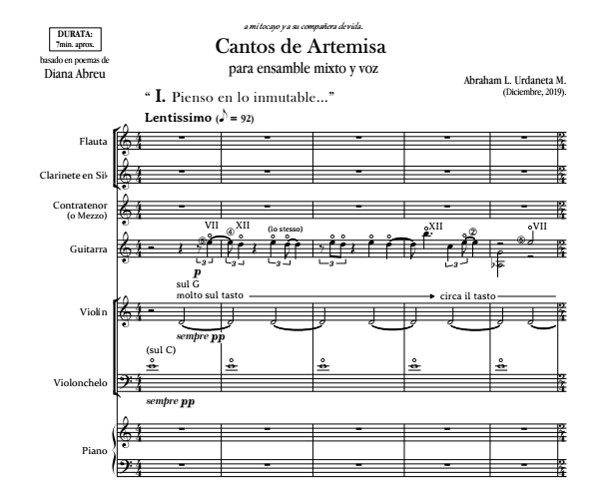G.F. Händel - Lascia Ch'io Pianga
Manuel Labrador: Contratenor / Countertenor.
Kevin Rodríguez: Teclado (cuerdas) / Keyboard (strings pad).
Abraham Urdaneta: Clavecín (fuera de escena)/ Harpsichord (off-stage).
Al escuchar el canto de un contratenor son muchas las preguntas que vienen al oyente: ¿Es natural ese tipo de voz? ¿Por qué existe una voz masculina que busca imitar a la femenina? ¿Cómo puede un hombre lograr manipular ese tipo de herramientas vocales? Todos estos planteamientos son completamente naturales, y pueden ser explicados a través del nacimiento y evolución de ciertas técnicas vocales. La trascendencia de este tipo de cantantes ha sido tal que no sólo conseguiremos fructíferas producciones y ejemplos en la música académica, también se podrán encontrar grandes logros en el campo de la música pop, urbana y comercial en general.
When listening to the singing of a countertenor there are many questions that come to the listener: Is that type of voice natural? Why is there a male voice that seeks to imitate the female? How can a man manage to manipulate those kinds of vocal tools? All these approaches are completely natural, and can be explained by means of the birth and evolution of certain vocal techniques. The importance of this kind of singer has been such that we will not only find fruitful productions and examples in academic music, but also great achievements can be found in the field of pop, urban and commercial music in general.
El origen de este tipo de voz ha sido muy distinto al que han experimentado las voces de soprano, contralto, tenor y bajo. El término “contratenor” nace de su uso en composiciones del final de la Edad Media; sin embargo, esta voz tomaría un rol más allá de la construcción polifónica para ser entendido como un registro vocal característico de voces masculinas que cantaban la parte de la contralto (voz grave femenina). Paralelo a esto proceso, el auge de los “castrati” -aquellos cantantes masculinos que eran castrados antes de la pubertad para así preservar su voz de niño- y contraltos como intérpretes de óperas tempranas y barrocas contribuyó a disminuir la atención del público y creadores a este tipo de voces. Es así como, en el amplio abanico de la música religiosa en estas épocas, los contratenores encontraron un lugar.
The origin of this type of voice has been very different from that experienced by the soprano, alto, tenor and bass voices. The term "countertenor" arises from its use in compositions from the end of the Middle Ages; however, this voice would take a role beyond polyphonic construction to be understood as a characteristic vocal register of male voices singing the contralto (female deep voice) part. Parallel to this process, the rise of the “castrati” - those male singers who were castrated before puberty in order to preserve their boyish voice - and contraltos as performers of early and baroque operas contributed to decrease the attention of the public and creators to these kinds of voices. This is how, in the wide range of religious music in these times, countertenors found a place.
El ocaso de la era de los Castrati | The fall of the Castrati Era
Tras la necesaria prohibición social de la castración como un mecanismo para gestar un rol vocal, los contratenores y su principio técnico en función del “falsete” experimentaron un auge importante a partir del s. XIX tras el aumento exponencial de la interpretación de “música antigua”. Es a partir de este fenómeno donde los contratenores sustituyeron a los castrados en la escena musical.
After the necessary social prohibition of castration as a mechanism to create a vocal role, countertenors and their technical principle based on "falsetto" experienced a significant boom from the 19th Century after the exponential increase in "early music" performances. It is from this phenomenon that the countertenors replaced the castrated on the music scene.
A partir del s. XX, algunos compositores decidieron, a través de la normalización de los contratenores en roles operísticos y de otra naturaleza no necesariamente religiosa, escribir obras pensadas para este tipo de voces: Benjamin Britten compuso el rol de Oberon en su ópera “Sueño de una noche de verano”, Leonard Bernstein agregó un solista de este tipo en sus “Salmos de Chichester”, Gounod el rol de Siebel de la ópera “Fausto”, Abraham Urdaneta compuso Cantos de Artemisa para solista contratenor y grupo de cámara, entre otros.
From the 20th Century, some composers decided, through the normalization of the countertenors in operatic and other not necessarily religious roles, to write works specially thought for this type of voices: Benjamin Britten composed the role of Oberon in his opera “A Midsummer Night's Dream”, Leonard Bernstein added a soloist of this type in his “Psalms of Chichester”, Gounod the role of Siebel of the opera “Faust”, Abraham Urdaneta composed Cantos de Artemisa for solo soloist and chamber group, among others.

A. Urdaneta - "Cantos de Artemisa", para ensamble mixto y voz, sobre textos de Diana Abreu | A. Urdaneta - "Cantos de Artemisa (Songs of Artemis)", from mixed instrumental ensamble and voice, settings from poems by Diana Abreu.
El uso de esta técnica ha trascendido de los espacios de la música académica y se ha introducido muy profusamente en los intérpretes de música popular y urbana. La incorporación del falsete coexistió en muchos casos con la voz natural, como puede apreciarse en la interpretación de Tony Williams de la canción Only You (1955), por el grupo The Platters. En otros casos, se empleó únicamente el falsete como la única técnica de canto durante toda la canción; uno de los casos más famosos de este uso es el sencillo Stayin’ Alive (1977), interpretado por el grupo Bee Gees. A la lista de cantantes que han aprovechado este recurso de manera más o menos extendida, figuran estrellas como: Michael Jackson, Justin Timberlake, Adam Levine, Vitas, Dimash Kudaibergen, Mika, Bruno Mars, Prince, entre otros tantos.
The use of this technique has transcended the spaces of academic music and has been introduced very widely in popular and urban music performers. The incorporation of the falsetto coexisted in many cases with the natural voice, as can be seen in Tony Williams' interpretation of the song Only You (1955), by the group The Platters. In other cases, only falsetto was used as the only singing technique throughout the song; one of the most famous cases of this use is the single Stayin ’Alive (1977), performed by the group Bee Gees. The list of singers who have taken advantage of this resource in a more or less extended way includes stars such as: Michael Jackson, Justin Timberlake, Adam Levine, Vitas, Dimash Kudaibergen, Mika, Bruno Mars, Prince, among many others.
¿Sabía todo ésto? ¿Conoces algún otro cantante que haga uso de estos recursos técnicos?
¡Déjanos tus comentarios!
Did you know all this? Do you know any other singer who makes use of these technical resources?
Leave us your comments!
Referencias | References
- Giles, Peter (1999). Les Contre-ténor, Mythes & Réalités. Peter Giles. Alemania.
- The Farinelli Manuscript (2019). Ann Hallenberg, Stefano Aresi. Glossa. Made in Austria.

Congratulations @archivero! You have completed the following achievement on the Hive blockchain and have been rewarded with new badge(s) :
You can view your badges on your board and compare to others on the Ranking
If you no longer want to receive notifications, reply to this comment with the word
STOPDo not miss the last post from @hivebuzz:
Vote for us as a witness to get one more badge and upvotes from us with more power!
This post was shared in the Curation Collective Discord community
community witness. Please consider using one of your witness votes on us here for curators, and upvoted and reblogged by the @c-squared community account after manual review.@c-squared runs a
Excelentes. Felicidades